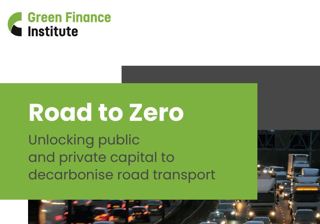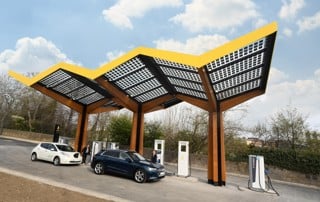Utilisation of the UK’s electric vehicle (EV) charging infrastructure has been revealed in a report from the Green Finance Institute and Zapmap.
The new report – which aims to help investors and local authorities look beyond the number of charge points installed as a success metric, and consider how to ensure the right charging devices are in the right place – shows how utilisation of charging has changed over time.
While to date there is no industry-standard definition or calculation for the utilisation of EV charging infrastructure in the UK, the report - aimed at local authorities, investors and charge point operators – provides ways to measure, understand and act upon utilisation rates.
Zapmap is able to record and analyse hundreds of thousands of charging sessions each month – from around 70% of all public charge points across the country.
The Green Finance Institute and Zapmap used this data to estimate two different forms of utilisation, each with their pros and cons.
First is the exact time-based utilisation of charge points – or the amount of time a vehicle is plugged into a charging device, but not necessarily charging.
This measure is useful for understanding when a charger is available for someone to charge.
Second is the estimated energy-based utilisation of charge points – in this case, the estimated energy delivered during a charging session, relative to the potential maximum energy that could have been supplied in the same period.
This measure gives more direct insight into the revenue a charger could provide.
With Zapmap tracking this data since 2018, the two organisations have been able to reveal how these two measures differ, as well as how they vary across power ratings and have changed over time.
The overall picture sees time-based metrics showing higher utilisation at a relatively even level across power ratings, with energy-based metrics demonstrating a lower level of utilisation that varies significantly across power ratings.
Despite significant growth in the number of pure-electric cars on the road and the country’s charging infrastructure between Q4 2021 and Q4 2022, the Green Finance Institute and Zapmap found that the time-based utilisation of charge points across most power ratings did not change significantly during this period.
On average, time-based utilisation increased from just under 14% in Q4 2021 to 15% in Q4 2022.
However, the analysis uncovered one exception to this trend, with the time-based utilisation of ultra-rapid chargers (100kW+) increasing from just over 12% to more than 16% over the same period.
This shows that ultra-rapid chargers are in high demand, even with the number of these devices increasing by 78% between the end of 2021 and the end of 2022 – the highest percentage increase of any type of charger.
Melanie Shufflebotham, co-founder and chief operating officer at Zapmap, said: “It’s great to see these utilisation figures coming into the public domain because they can really help us move the conversation on from simply talking about the number of charge points to looking more closely at charging behaviour and patterns on different types of chargers.
“This in turn can help to inform local authorities and investment, ensuring the right charging provision is installed in the right places.
“As ever, new analysis often raises more questions than it answers. But one clear trend that both measures highlight is the increasing utilisation of ultra-rapid charge points, and an expectation that this will continue as more vehicles enter the market with improved charging capabilities.”
Ultra-rapid chargers
Furthermore, the two organisations found that ultra-rapid chargers bucked the trend in terms of energy-based utilisation too.
This measure of charge point utilisation demonstrates the estimated energy delivered during a charging session, relative to the potential maximum energy that could have been supplied in the same period.
While rapid chargers (25-99kW) showed an energy-based utilisation of 10.6% in Q4 2022, the same measure of utilisation saw their higher powered, ultra-rapid counterparts sitting at just 4.4%.
The analysis uncovered a wide gap between the two utilisation measures for ultra-rapid devices – 16.1% for time-based utilisation and 4.4% for energy-based.
A key factor explaining this gap is that there is often a difference between the max power rating of a charge point and the charging capabilities of the electric vehicle.
In parallel, the ‘charging curve’ – in which electric vehicles only charge at peak rate for a proportion of the charge – also has an impact, as does the difference between advertised power and delivered power.
However, as the charging capability of electric cars, the charge point technology and the delivery of energy from the grid improves over time, the Green Finance Institute and Zapmap expect to see the difference between these two measures of utilisation start to decrease.
Lauren Pamma, director for transport programmes at the Green Finance Institute, said: “The Green Finance Institute has been delighted to work with Zapmap to create clarity for the market on how the charging network in the UK is used.
“Uniquely positioned at the nexus of public and private finance, the Green Finance Institute is the UK’s principal forum for innovation on green finance and delivery across the market.
“We engage regularly with financial institutions who have made clear to us that utilisation risk continues to be the key barrier preventing them from financing EVCI.
“The data in this white paper is the start to providing financiers with the information and clarity they need to understand utilisation, and therefore reduce the risk in financing the infrastructure underpinning the EV transition.
“Zapmap’s data has the potential to enable innovative financing mechanisms such as utilisation-linked loans, which the Green Finance Institute has been developing, to be realised.”
Jade Edwards, head of insights at Zapmap, added: “It’s been fantastic working with the Green Finance Institute to help demystify the utilisation of the UK’s EV charging infrastructure.
“First and foremost, this pioneering report will not only help local authorities, investors and charge point operators understand utilisation rates and patterns for charge points across the UK. It also establishes two effective ways to measure, interpret and act upon utilisation rates.
“While there’s obviously no industry-standard definition or calculation for utilisation at present, it’s great to be able to put Zapmap data to good use, and work with GFI to produce reliable, credible information that will ultimately help to enable a smooth and fair transition to electric mobility across the country.”
Zapmap Insights has developed a range of products that enable the industry to understand the patterns of utilisation across the UK’s public charging network as a whole, helping to support both benchmarking requirements and investment decisions.
























Login to comment
Comments
No comments have been made yet.